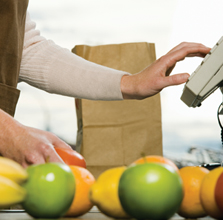Walgreens, with 8,229 drugstores nationwide in 2014, began selling fresh fruit and vegetables as a pilot program in 2010. The company also committed to opening 1,000 “food oasis” stores by the end of 2016 in geographic areas lacking full-service grocery stores. CVS Pharmacy, with more than 7,600 retail drugstores, jumped on the fresh produce bandwagon in 2010 as well, with a plan to include fresh fruits and salads in a fifth of its stores nationwide.
Consumer demand for organic fruits and vegetables continues to grow as well. To distinguish itself from competitors, 99 Cents Only stores now stocks organics alongside its seasonal selections of produce. Dollar General appealed to middle class and upscale shoppers by adding ‘Dollar General Markets’ in select cities in 2011 and 2012. These larger stores feature wider aisles and are more like traditional grocery stores with both perishables and daily necessities at competitive prices.
More important, perhaps, are the many convenience stores in or near neighborhoods designated as food deserts. A location is considered a food desert if residents live more than a mile away from a grocery store in an urban area or 10 miles in a rural area. The U.S. Department of Agriculture estimates nearly 26 million Americans live in food deserts—with 18,000 convenience stores located in these areas, adding fresh fruits and vegetables offers a distinct market advantage.
Barriers to Fresh Produce Sales
Despite the growth of food sales in convenience stores, drugstores, and dollar stores, they are still not top-of-mind for most shoppers when it comes to purchasing produce. Shelf space is limited, and as a result, variety suffers. And budget-minded consumers can’t find the kinds of promotions sales found at traditional supermarkets and supercenters, like Walmart.
Some consumers also continue to hold a negative perception of convenience stores. A 2013 NACS survey found only 38 percent of respondents considered C-stores as a place to get fresh food; 82 percent believed prices were too high; 78 percent believed only ‘unhealthy’ food could be found in stores; and 73 percent said the stores needed to do more to address health and wellness.
On the vendor side, assessing demand is a big challenge for operators unaccustomed to stocking fresh fruit and vegetables, with their limited shelf life. Product must be monitored on a regular basis and rotated if produce items spoil. For smaller stores, finding suppliers can be a detriment to stocking perishables. A 2014 report from ChangeLab Solutions found minimum purchase requirements and delivery fees were often prohibitive, and suppliers that did offer reduced quantities charged fees for splitting cases. Lenard acknowledges the problem, noting that access to affordable fresh foods “is the big nut we have to crack for smaller operators.”



